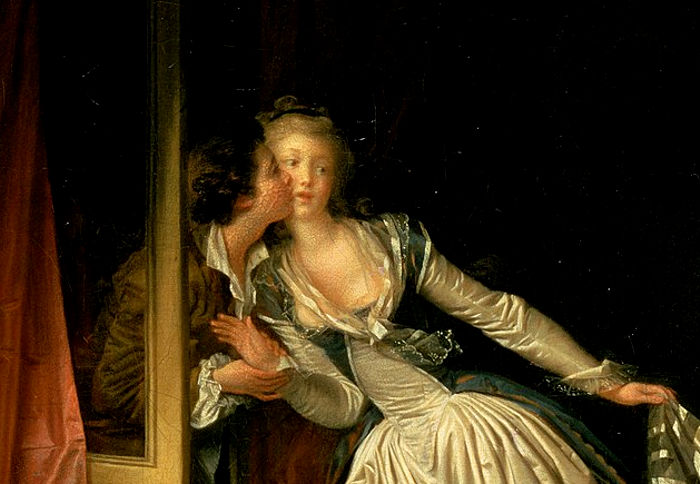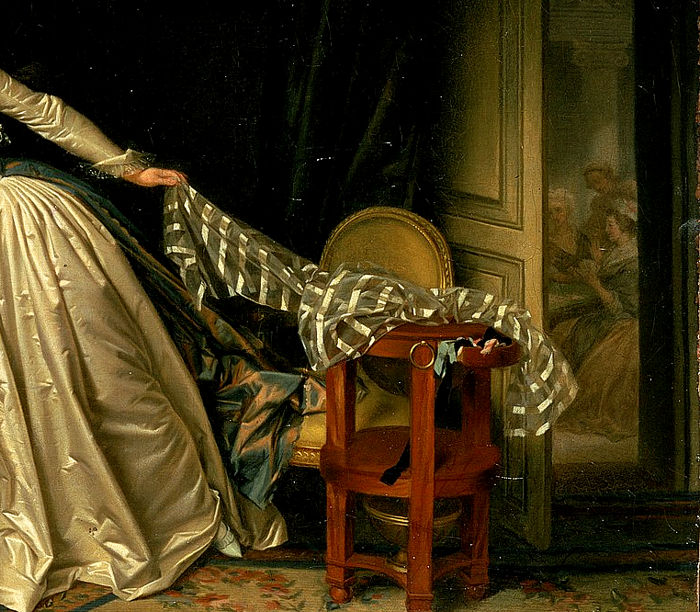A young man, standing in a doorway, draws a young woman to steal a kiss from her... which she seems to have come looking for! The eroticism of stolen pleasure is the third party between two worlds. Two attitudes are expressed by the posture, the face of this young woman, divided between the attraction of forbidden fruit and respect for morality. “The Stolen Kiss” (Le Baiser à la dérobée) by Jean-Honoré Fragonard represents a frozen instant of furtive intimacy between two lovers.
A Scene of Secrecy and Luxury Before the Storm
The painting shows a young woman in a cream-colored silk dress who has left the group of ladies in the next room for a secret meeting with a young man. Fragonard's painting, created around 1790, just on the eve of the French Revolution, displays the kind of eroticism and romantic folly that was popular, though increasingly criticized, among the French aristocracy.
This scene of voyeurism depicts the stolen kiss in a luxurious and decadent setting. The artist envelops us in an atmosphere of opulence, containing luxurious details of textures, silks, and laces. We can observe the floral patterned carpet, the silk curtains that frame the action, her shawl carelessly thrown over the chair (a symbol of haste and abandon), and the elegantly dressed ladies who are visible, oblivious to the drama, through the open door.

The Sociocultural Context of Rococo
The dominant French culture of the court of Louis XV, and later the excesses of the court of Louis XVI, heavily influenced Fragonard's subjects. His works were mostly romantic or secretly erotic love scenes, painted for the enjoyment of the pleasure-loving nobility. The Rococo style, which emerged as a reaction against the geometric formalism and seriousness of the Baroque, sought grace, lightness, sensuality, and joy. It was characterized by:
- Light and soft colors (pastels).
- Asymmetrical designs and curved, natural forms.
- Themes that focused on the leisurely life of the nobility, love, and light mythology.
The Rococo style, which spread to other parts of Europe (mainly Northern Italy, Bavaria, Austria, and Russia), influenced all the arts, from sculpture and furniture to music and theater. Fragonard became a prominent painter within this movement, producing over 550 paintings, and his most famous works convey precisely that atmosphere of intimacy and veiled eroticism.

Composition and Fragonard's Technical Mastery
Fragonard's skills as a master of color and composition are fully evident in this work. He uses the architecture of the scene to frame and direct the viewer's gaze:
- The Diagonal Composition: The main diagonal axis is composed of the young woman's leaning figure, her extended arm, and the shawl placed diagonally across the table. This dynamic line introduces a sense of movement, haste, and instability, emphasizing the fleeting and forbidden nature of the kiss.
- The Framing: The main action is skillfully framed by the two open doors. The left door gives us a view of the adjacent room, full of chatting ladies—a world of decorum from which the protagonist has just escaped. The frame of the right door encloses the lovers in a secret space, intensifying the intimacy.
Fragonard offers us a series of brilliant compositional contrasts: the contrast between the light bathing the lovers and the shadows of the hallway, the contrast between the cool colors of the background and the warm colors of the young woman's dress, and the complex spatial intersections that lend depth and mystery to the scene.
The rapid, fluid, and vibrant brushwork, characteristic of the painter, imparts a marvelous sense of movement to the silk of the young woman's dress and the lace, almost making them palpable.
The Inner Conflict: Morality and Desire
The true genius of "The Stolen Kiss" lies in the young woman's ambiguity. Her posture says it all:
- Her body is slightly tilted back, as if she wants to resist—a pose of modesty.
- Her extended arm (holding the shawl) seems to push away, or at least attempt to maintain a distance with the ladies' room.
- However, her face is tilted toward the young man, and her lips are ready to receive the "stolen kiss."
This duality is the heart of the late Rococo. The young woman is divided between the morality imposed by society (the group of ladies, the open door) and personal desire (the young man and the attraction of forbidden fruit). The viewer is left to wonder: Is it truly a "stolen" kiss, or is it a mutual pleasure that requires the social excuse of theft to be acceptable? The title, Le Baiser à la dérobée (The Kiss on the Sly), suggests that transgression is a fundamental part of the charm.

Poetic Dialogue: Fragonard and Gabriela Mistral
"El beso" (The Kiss), a classic poem by the great Chilean poet Gabriela Mistral (Nobel Laureate in Literature), perfectly complements Fragonard's painting. Both explore the kiss as an act of intense, secret, and transgressive passion:
Here is the original Spanish poem
"Hay besos que producen desvaríos
de amorosa pasión ardiente y loca,
tú los conoces bien son besos míos
inventados por mí, para tu boca.
Besos de llama que en rastro impreso
llevan los surcos de un amor vedado,
besos de tempestad, salvajes besos
que solo nuestros labios han probado.
¿Te acuerdas del primero…? Indefinible;
cubrió tu faz de cárdenos sonrojos
y en los espasmos de emoción terrible,
llenáronse de lágrimas tus ojos.
¿Te acuerdas que una tarde en loco exceso
te vi celoso imaginando agravios,
te suspendí en mis brazos… vibró un beso,
y qué viste después…? Sangre en mis labios.
Yo te enseñe a besar: los besos fríos
son de impasible corazón de roca,
yo te enseñé a besar con besos míos
inventados por mí, para tu boca".
Excerpt from El beso by Gabriela Mistral
While Fragonard captures the fleeting moment of the beso vedado (forbidden kiss) with brushstrokes of silk and light, Mistral tears it apart with the intensity of ardent and wild passion. The painting is the grace of secrecy; the poem, the confession of the storm. The young woman in Fragonard's work has the cárdenos sonrojos (crimson blushes) that Mistral mentions. Both works remind us that the true erotic power of the kiss lies in its forbidden, or at least secretive, nature.
We invite you to enjoy a video featuring works where the kiss is the protagonist, complementing this artistic exploration.
{youtube qoV_n2IIX10}
THE WORK
Title: The Stolen Kiss (Le Baiser à la dérobée)
Artist: Jean-Honoré Fragonard
Date of Creation: 1788-1790
Technique: Oil on Canvas
Style: Late Rococo
Size: 17.7 in × 21.7 in (45 cm × 55 cm)
Location: Hermitage Museum, St. Petersburg, Russia



